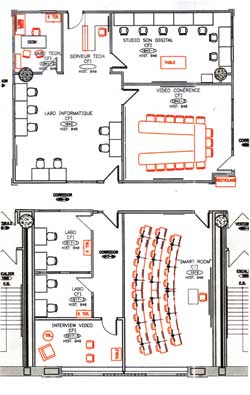Concordia Corner
The future of history

The 10th floor of the Library building is about to be transformed into a one-of-a-kind laboratory for the recording, preparing and archiving of digital history. The Digital and Oral History Lab will serve both students in the burgeoning program as well as other researchers interested in learning the techniques associated with recording the past for posterity.
The lab will also be accessible to community groups eager to preserve stories related to a particular region or population.
courtesy digital history lab
Concordia is poised to make history in more ways than one.
The Centre for Oral History and Digital Storytelling is currently moving into its permanent home on the 10th floor of the library building. With $350,000 in CFI funding and state-of-the-art equipment, we will boast the first lab of its kind in the country.
Yet the shift from dusty paper volumes to digital ones is not necessarily evident.
“Five or six years ago, people were asking why would you record information this way. Traditional history is one of the most conservative disciplines in terms of new technology,” said Steven High, Canada Research Chair in Public History.
Yet the possibilities for digital history are enormous. A great deal of the information conveyed in tone, pace, dialect, emotions and body language is lost when an oral narrative is transferred to the printed page.
“It’s not just a question of capturing video; that’s been done all over. Until now, if you didn’t watch the tape, you would go through a transcript. And you would lose what’s really unique about oral history, the voice of the person speaking,” said High.
Having someone produce the transcript meant extra costs and time necessary to access the material. “One of the problems with analog recording is that one and a half hours of tape equals one and a half hours of time spent viewing it,” High said.
His team is halfway through developing a prototype program with researchers at the University of Buffalo which will allow for digital files to be searchable. Essentially, they will be creating the digital equivalent of the index at the back of a book.
The new software (also being developed with CFI funds) would allow future researchers to scan through a bank of dozens of videos related to the same theme and seek out specific keywords or subject categories. They could then watch the relevant clips of those interviews back-to-back.
High’s colleague Elena Razlogova has SSHRC funding to develop a freeware version of this software, to make it accessible to grad students or amateurs.
The new laboratories will incorporate the digital archive. They will also feature workstations (each terminal requires massive hard drive space because video takes up so much memory) where students can record and edit their material. There will be a space for videoconferencing, bringing experts together virtually from around the world.
The workstations had been temporarily set up in a handful of rooms with a mini-library of related books along a shelf and small cupboards full of palm recorders and other equipment for researchers to use.
High uses his research chair funding to pay two grad student interns to co-manage day-to-day operations of the centre, keep track of the equipment and provide support for those using it, including training.
The labs will have a 16-station oral history training facility capable of teaching the software and techniques useful for digitizing history (everything from Photoshop to Dreamweaver to interview ethics) to up to 32 people at once. These training programs are available to students whether in or outside the department, along with faculty, staff and representatives from the community at large.
“We’re trying to create a community and bring people together” High said. Training has already been offered to the Dawson Community Centre in Verdun for members to conduct interviews, as well as groups on the West Island interested in recording and preserving the area’s past.
High has also worked with representatives from the Centre d’histoire de Montréal. They have recently joined a network of virtual museums intended to allow individuals the opportunity to record their lives into a collective social memory. Developed in Brazil in 1991, the program has expanded around the globe. High’s team gave them a half-day workshop on techniques and challenges to address in developing the program.
Ironically, High will miss the big move. He’s off to the JFK Institute at the Free University of Berlin for a three-month-long fellowship. When he returns, he will greet students in the new facilities.